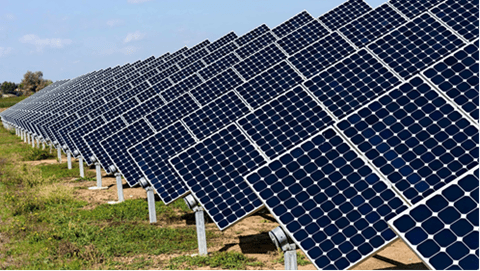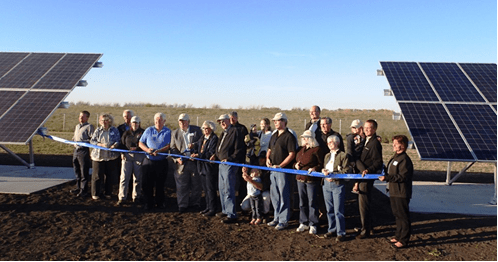Responsible Renewables Series: Solstice’s Approach to Empowering Communities with Clean Energy
This blog is part of our series spotlighting leaders in the pursuit and development of Responsible Renewables projects. This series is being hosted in collaboration with Schneider Electric and Korn Ferry. For a background on responsible renewables, we encourage you to start with the introductory blog, which explores the issues and opportunities.
 In our latest installment of the Responsible Renewables series, we spotlight Solstice, a pioneering company in the community solar sector. Founded in 2015 by Sandhya Murali and Steph Speirs, Solstice has evolved from its nonprofit roots into a dynamic organization bridging the gap between large-scale solar developments and the communities they serve. Initially focused on ensuring equitable access to solar power, Solstice recognized the need for a seamless customer experience and robust management solutions for solar developers.
In our latest installment of the Responsible Renewables series, we spotlight Solstice, a pioneering company in the community solar sector. Founded in 2015 by Sandhya Murali and Steph Speirs, Solstice has evolved from its nonprofit roots into a dynamic organization bridging the gap between large-scale solar developments and the communities they serve. Initially focused on ensuring equitable access to solar power, Solstice recognized the need for a seamless customer experience and robust management solutions for solar developers.
Today, Solstice boasts a platform with over 12,000 subscribers and collaborates with leading solar developers to expand clean energy access and help corporations achieve their sustainability goals, casting a net wider than originally imagined for equitable access to clean energy.
 .
.
Join us for an in-depth conversation with Sandhya Murali, co-founder and CEO of Solstice, as we explore the company's origins, challenges, and future aspirations.
.
.
Can you tell us about the history and background of Solstice?
We started as a nonprofit organization, with a strong commitment to ensuring equity and inclusion were woven into the energy transition. As we began our community engagement work, we identified an untapped niche where we could add significant value, by connecting people and communities to large-scale community solar farms being developed so that everyone had the choice to receive clean energy.
Initially, we played the customer engagement role, working closely with communities and developers to subscribe their projects and get them filled. However, we soon realized there was a need for a better customer experience. People would express interest and were ready to sign up, but the handover process to the developer was cumbersome and disjointed. Additionally, developers were asking us to manage hundreds and eventually thousands of customers, as they didn't have the capabilities to do so. Recognizing this opportunity to make the process seamless for everyone, we decided to expand our efforts to handle both the initial customer engagement and enrollment process with the developers, long-term for a true customer relationship partnership. Today, we have more than 12,000 subscribers on our platform and work with a dozen of the nation's leading solar developers. This is now setting us up for success to additionally work with corporations with ambitious sustainability targets.
How does community solar work?
Community solar works as an option for those who can't or don't want to install panels on their rooftops. For instance, if you rent, don’t have the amount of roof space required for your consumption, or are unable to receive financing due to strict credit requirements, you have the ability to sign up for a community solar farm. The clean power from these projects is then sent back to the local grid, and everyone who signed up for the project receives a credit on their utility bill for their share of the power produced. Solstice then charges a discounted rate for those credits in order to use the clean energy and save money. For example, if you get $100 of credits
How does Solstice operate within the community solar landscape?
 At Solstice, our primary clients include the developers building the community solar farms
At Solstice, our primary clients include the developers building the community solar farms
Currently, Solstice operates in six states: Massachusetts, New York, Illinois, New Jersey, Minnesota, and New Mexico. We're actively seeking opportunities to expand into additional states. It's important to note that within each state, we must align with the utility territory where the project is located from the customer's perspective, as community solar programs vary significantly across the 24 states where they are available.
What is Solstice’s role in community education?
When we engage with communities, we often encounter skepticism because the concept of community solar can seem too good to be true. Residents don't have to pay anything up-front to sign up, and yet they can save up to 60% on their utility bills. Naturally, people wonder, "What's the catch?" To overcome this skepticism, we rely on transparent, trusted partnerships with municipalities or community organizations and build community campaigns.
In states with established community solar programs and administrators, such as those with dedicated websites explaining how it works, it becomes smoother to educate potential customers because they likely have already heard about the program. Throughout the enrollment process, whether someone sees an advertisement, receives a promotional mailing, or hears about Solstice at a community event, we ensure there's continuous education about how community solar functions and what it means for them. Many individuals may not actively seek out community solar or clean energy options, so we provide resources to help them understand what to expect.
Once customers sign up and await activation of their assigned solar farm, we keep them informed with pertinent updates such as when their solar farm will start producing power and what they can anticipate seeing and paying on their first bill. This proactive approach to education during the initial signup process helps ensure that customers understand the program fully and are less likely to churn or cancel due to misunderstanding. Overall, educating customers about this new experience is crucial to ensuring their satisfaction and engagement with community solar.
How does Solstice collaborate with government and stakeholders to influence policy in the community solar sector?
We have a dedicated policy team that focuses on community solar regulations and incentives, which are primarily decided at the state level. With the recent federal incentive under the Inflation Reduction Act (IRA), we now have a national framework alongside state-specific policies. Our team actively participates in policy discussions and program crafting to ensure customer-friendly policies and effective program design.
Our goal is to advocate for well-designed programs from the outset as a poorly designed program can complicate implementation and execution, which is what we want to stay away from. We strive to influence and advocate effectively throughout the policy-making process, aiming to shape policies that benefit the entire community solar industry.
What are some major challenges faced by Solstice?
Initially, we tried to handle everything internally. Our team was out in the field, engaging directly with potential customers. When COVID-19 hit and in-person engagement became challenging, we had to pivot to working through partners and building trust virtually and digitally. One of the key lessons we learned early on was the importance of partnerships and leveraging existing networks of trust. Our sales team focuses on building relationships within communities, aiming to create a network that fosters referrals and sustained growth. We collaborate closely with various organizations, whether municipalities, large nonprofits, or employers, who help disseminate information about signing up for community solar among their members and residents. Maintaining strong relationships is critical as we manage these projects. Ensuring full subscription, managing billing services, and collecting payments require close collaboration with utilities. Our asset management team has developed strong relationships with utility counterparts, especially crucial in navigating new and evolving programs.
Another challenge we've faced on a broader scale is project delays, often due to interconnection issues, utility challenges, or supply chain disruptions. These delays impact timelines for customers expecting to see savings on their bills. To address this, we've adapted our processes to anticipate delays, prioritize transparency, and keep customers informed about any setbacks.
Do you have a particular initiative or accomplishment you're most proud of within the past few years?
One initiative I'm particularly proud of is our churn prediction model. Over the past five or six years, we've gathered substantial data and insights into our customers' behavior. Recognizing that customer churn poses a significant risk to project management, our team developed this model to address it proactively.
The churn prediction model is based on comprehensive customer data, which is updated monthly with new payment information. Its primary goal is to identify factors that increase the likelihood of customers leaving a project. We run the model regularly, either monthly or quarterly, to pinpoint customers at the highest risk of churning. Once identified, we employ targeted interventions to keep the customer engaged on their project
These interventions can be straightforward, such as additional touchpoints through calls, emails, or texts to understand the customer's situation. For instance, if a customer plans to move, we explore options to transfer their subscription to their new address. We also engage new occupants of the vacated property to encourage their participation. Leveraging this data allows us to manage projects more intelligently, ensuring both project stability and a positive customer experience.
Common reasons for churn, aside from relocation, include prolonged project delays that prevent customers from seeing expected savings. Addressing these challenges requires tailored interventions based on specific circumstances. Though we are still in the early stages, the potential of this advanced model is exciting and essential for scaling our operations while maintaining high customer satisfaction.
Did Solstice utilize AI to develop its machine learning models, or were these models created and refined by data scientists?
We have a data scientist on our team who has been instrumental in conceptualizing and building our models. They have explored innovative ways to leverage our extensive customer data for initiatives like our churn prediction model. Another significant project we've worked on, and are currently commercializing, is the EnergyScore.
Initially, our focus was on signing up customers for community solar subscriptions, which typically required a 20-year commitment and high FICO credit scores. This made it challenging to reach customers who were interested in solar but couldn't install rooftop panels due to various reasons like shading or roof orientation. Many of those we signed up were already prime candidates for rooftop solar but couldn't pursue it for practical reasons.
In collaboration with the Department of Energy, MIT, and Stanford, we developed the EnergyScore. This machine learning model integrates utility payment history and credit data to provide an alternative credit metric beyond traditional FICO scores. Initially designed for the rooftop solar context where FICO scores remain a significant barrier, our goal is to expand its application to enhance accessibility across different solar markets.
Over the past five to six years, the community solar industry has shifted away from stringent FICO score requirements, favoring flexibility to accommodate customer needs and ensure project sustainability. This shift has bolstered confidence among financing partners, making community solar projects more viable. Our EnergyScore initiative remains focused on democratizing solar access, particularly for low-
Solstice is a pioneering force in community solar, leveraging innovation and partnerships to expand clean energy access. Their commitment to equity and sustainability drives impactful solutions that bridge communities with large-scale solar developments, shaping a more inclusive and resilient renewable energy landscape.